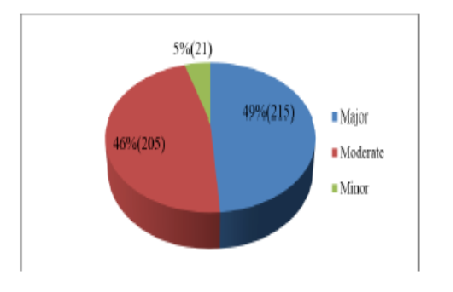


Indian Journal of Science and Technology
Year: 2022, Volume: 15, Issue: 33, Pages: 1634-1641
Original Article
Ann Vazhayil Kuruvilla1, M Ramesh1*, C P Madhu2
1JSS College of Pharmacy, JSSAHER, Mysuru, Karnataka, India
2JSS Medical College and Hospital, JSSAHER, Mysuru, Karnataka, India
*Corresponding Author
Email: [email protected]
Received Date:13 January 2022, Accepted Date:02 August 2022, Published Date:27 August 2022
Objectives: To assess the nature of drug-related problems (DRPs) associated with antibiotic use and to evaluate the level of significance of clinical pharmacist interventions in surgical care. Methods: This prospective interventional study was carried out for 1 year in the wards of General Surgery. The in-patients were followed daily and reviewed for DRPs. The identified DRPs were categorized according to the Hepler and Strand classification. Drug-related problems other than those in Hepler and Strand classification were categorized separately based on medical literature and clinical practice evidence. The identified DRPs were conveyed and discussed by the clinical pharmacist with the surgeon, and ideal suggestions for further action. A bivariate logistic regression analysis was performed to identify the predictors of the DRPs associated with antibiotic use. Findings: Of the 614 patients, 64.49% were males. 414 DRPs were identified, wherein improper duration of drug use (20.86%) was the most common DRP. The significance level of pharmacist intervention was found to be ‘major’ in 49% of cases. The incidence of DRPs associated with antibiotic use was 67.42%. The rate of acceptance of pharmacist interventions was 99%. A strong association between the occurrence of DRPs and age, the presence of two co-morbid conditions, the intake of two and three antibiotics, and length of stay (LOS) of 6–10 and 16–20 days (P < 0.05) was noted. Conclusion: Even though antibiotics are necessary for surgical management, their vigilant use is warranted. The clinical pharmacist plays an enormous role in optimizing antibiotic therapy in surgical patient care. Novelty: To the best of our knowledge, such an interventional study of its kind that exclusively focused on the surgery ward was not conducted in India previously, and not many studies of a similar kind have been carried out in other parts of the world that have assessed the prevalence and frequency of DRPs related to antibiotic use, the predictors associated with the DRPs, the role of clinical pharmacists in the surgery ward, and the acceptance rate of pharmacist interventions by the surgeons. Here, an attempt to identify the predictors of drug-related problems associated with antibiotic use was made to help prevent and resolve drug-related problems earlier, therebypromising optimized therapy. Also, it highlights the importance of a clinical pharmacist’s role in surgical care regarding patient safety.
Keywords: Antibiotics; Surgery; Clinical Pharmacist; Predictors; Interventions; Drug Related Problems
© 2022 Kuruvilla et al. This is an open-access article distributed under the terms of the Creative Commons Attribution License, which permits unrestricted use, distribution, and reproduction in any medium, provided the original author and source are credited.
Published By Indian Society for Education and Environment (iSee)
Subscribe now for latest articles and news.